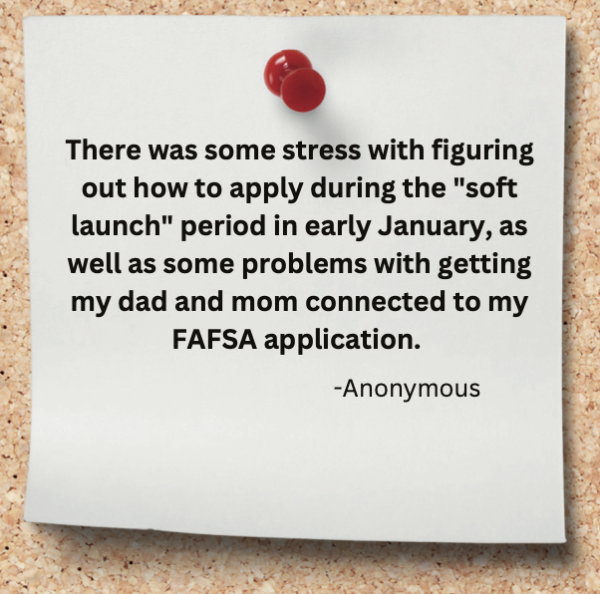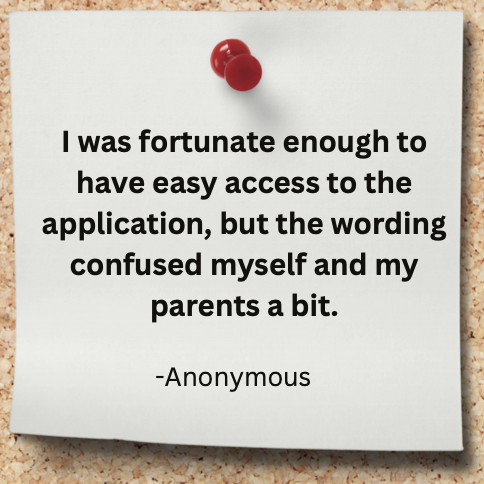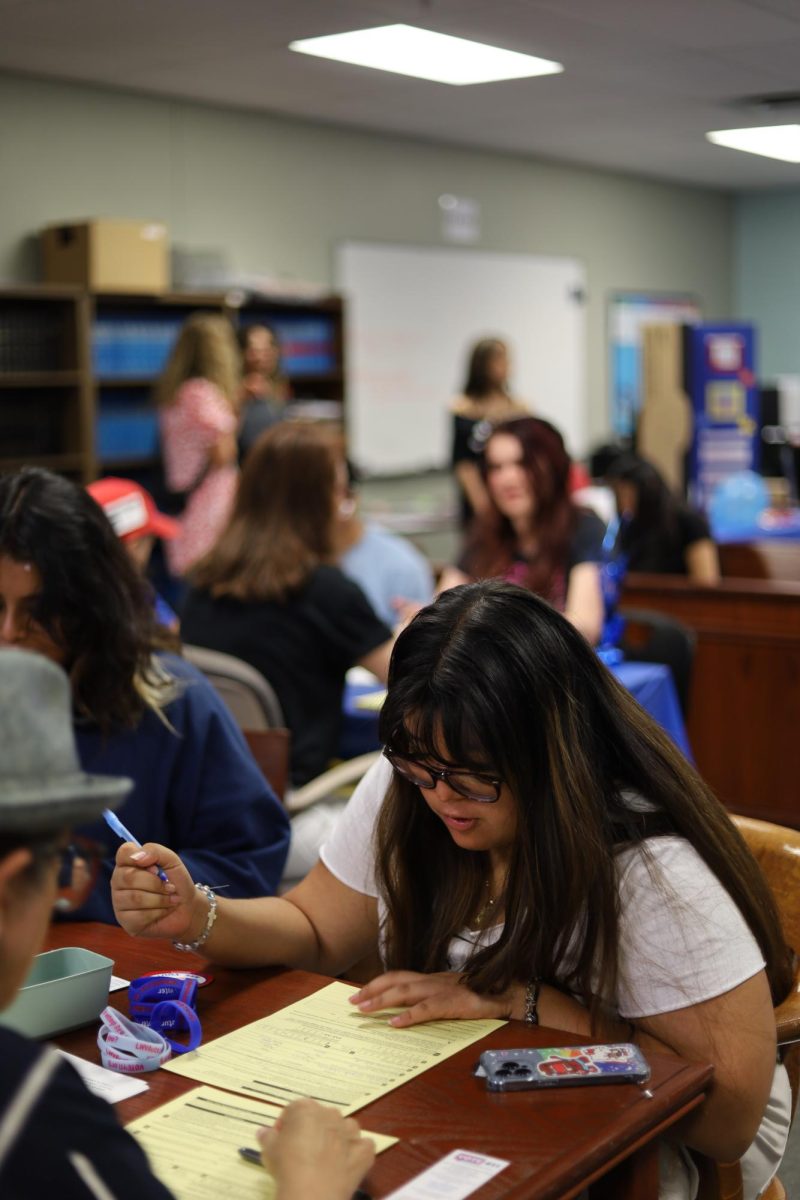The cost of tuition is the number 1 reason why students decide to not pursue college, according to a survey by the Gallup and Lumina Foundation. This means a majority of the next generation of students’ prospects are dependent on their financial aid, and unfortunately, this year has become a tricky and difficult time for many students looking to receive this financial aid.

What is FAFSA?
In 1992, the Free Application for Federal Student Aid (FAFSA) was released as a way for incoming college students to easily apply for federal low-interest loans and grants to help them pay for their college educations. Since then, the application process officials have tried to make the form simple and streamlined; in 2020, Congress passed the FAFSA Simplification Act, which provided the U.S. Department of Education with the money and resources to overhaul and simplify the 2024-25 FAFSA form. This year’s form had many major updates and changes, including decreasing the maximum number of questions on the form from 108 to 46 questions.
But many applicants, such as the senior class of 2024, parents, and counselors, have expressed frustration and confusion at the new form, creating problems for potential college students.
FAFSA 2024-25 Release
The FAFSA process typically opens on Oct. 1 for graduating seniors to begin applying if they plan to pursue higher education, as well as for other students already enrolled in college who qualify for the grant. Applicants try to get all their information ready in advance, waiting until midnight for the federal grant to open to begin applying.
 Since the federal grant works on a first-come-first-served basis — with the first applicants getting the most money — every incoming and current college student rushes the moment the form opens to try and make the most out of it. However, it became tricky this year after the Department of Education announced in March that the application opening would be delayed until December due to the updated form. The final announcement for the deadline wasn’t made until Dec. 1, when students found out the release for the application would be on Dec. 31, the very end of the year.
Since the federal grant works on a first-come-first-served basis — with the first applicants getting the most money — every incoming and current college student rushes the moment the form opens to try and make the most out of it. However, it became tricky this year after the Department of Education announced in March that the application opening would be delayed until December due to the updated form. The final announcement for the deadline wasn’t made until Dec. 1, when students found out the release for the application would be on Dec. 31, the very end of the year.
However, the form wouldn’t be readily available for everyone. Instead, they would release FAFSA in a “soft launch,” where the form would be released periodically throughout the day to monitor the website and applications and be on the lookout for any glitches reported. But this way of opening the form gave many applicants problems, such as difficulty accessing the application at the right time, and even having the application period close on them while completing it.
“The window to start new forms and access existing forms popped up infrequently and only for a short period of around an hour.” Senior Brandon Wicken said. “This means you had to constantly be on watch if you couldn’t complete it in one session.”
Undocumented Parents/Parents with no SSN
One of FAFSA 2024-25’s biggest controversies is the current inability for students who have parents with no Social Security Number to apply for the form.
Unlike previous year’s FAFSA forms, 2024-25 adds a new feature with the requirement to add “Contributors,” or people who are associated with your tax information and dependency, typically parents or guardians. The addition was made to easily share tax information to FAFSA, as it allows the contributor to directly share their IRS tax information with the Department of Education. However, there’s a glitch preventing parents without a Social Security number from being able to submit their IRS information.
 This means that students with undocumented parents, or just parents without a Social Security number, are unable to apply to FAFSA at the time of writing this because it provides no options or alternatives to applicants in this situation. This means that even a top ranking student in their high school can’t receive federal financial aid if their parent or guardian is an undocumented immigrant, a problem that wasn’t present in previous years and has frustrated and outraged this year’s applicants.
This means that students with undocumented parents, or just parents without a Social Security number, are unable to apply to FAFSA at the time of writing this because it provides no options or alternatives to applicants in this situation. This means that even a top ranking student in their high school can’t receive federal financial aid if their parent or guardian is an undocumented immigrant, a problem that wasn’t present in previous years and has frustrated and outraged this year’s applicants.
The problems with FAFSA hurt students because financial aid is often the deciding factor as to whether they attend college, with many colleges only offering scholarships when they receive FAFSA information.Because the financial aid works on a first-come first-serve basis, these students will be at a severe disadvantage compared to those who applied first.
 Even students with parents who do have a Social Security number can still have difficulty completing the form, as not all parents have the time or understanding to complete the form. However, this new requirement forces the parent or guardian of dependent students to complete the form and make an account as well, as opposed to previous years’ forms which would allow the student to fill the tax and financial information themselves instead.
Even students with parents who do have a Social Security number can still have difficulty completing the form, as not all parents have the time or understanding to complete the form. However, this new requirement forces the parent or guardian of dependent students to complete the form and make an account as well, as opposed to previous years’ forms which would allow the student to fill the tax and financial information themselves instead.
“I think that one big part that we try to do in education is everything should be inclusive,” Akins Texas Advisor, Janaya Brock said. “It should not be so drastically different that it’s creating such trouble for everybody. It should not be so different that when I’m working with two different students that I’m having to call them out in a classroom. That is not the goal of education at all. The whole point of education is to create equity.”
Formula for Financial Aid
One of the biggest changes to the 2024-25 FAFSA form is the new formula used to calculate the amount of financial aid given to each student. Previously, the Department of Education used a formula called the Expected Family Contribution, or EFC, to calculate the amount given. This year, a new formula for the form was created, known as the Student Aid Index, or SAI, which apart from renewing the calculations, also doesn’t take the number of family members currently in college into account, which increases many students who are part of their family’s first generation to attend the college.
 But the SAI formula was released with glitches and issues, including forgetting to take inflation into account. While the Department of Education did state on Jan 30th that they hadfixed this issue, providing an additional $1.8 billion to applicants, this still means that all submitted forms will need to be re-processed through a new formula. The Department of Education stated this will cause even more delays, and students shouldn’t expect to receive results and numbers until early March, negatively impacting even more students’ decisions about attending college.
But the SAI formula was released with glitches and issues, including forgetting to take inflation into account. While the Department of Education did state on Jan 30th that they hadfixed this issue, providing an additional $1.8 billion to applicants, this still means that all submitted forms will need to be re-processed through a new formula. The Department of Education stated this will cause even more delays, and students shouldn’t expect to receive results and numbers until early March, negatively impacting even more students’ decisions about attending college.
March Deadline Looming
Despite attempting to create a more streamlined, simpler process for 2024-25 FAFSA applications, many students and parents criticize the new form’s complicated system and guidelines that make it more difficult compared to previous years. The current status of this year’s form is preventing many incoming college students from knowing how much financial aid they’ll receive, a factor which for many is dictating whether or not they’ll be going to college, and, in turn, their entire future.
“So I believe the changes were to make [the FAFSA form] easier,” GEAR UP Facilitator, Laura Noack said. “But it’s not quite there yet. They’re trying to figure it out. And hopefully it gets there before the March deadline, where our students don’t lose out on the funds and they’re really working hard to try to figure it out.”
















